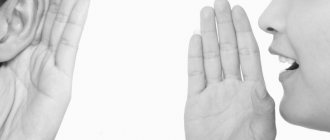Man's place in society
Society consists of numerous groups of people, public organizations, and individuals connected by relationships. These relationships are regulated by social norms - rules of behavior accepted in society. But these rules are not the same for everyone; what is possible for some people is prohibited for others.
A police officer can carry a weapon and use force against violators of public order, but this does not mean that all other members of society have such rights. Social statuses and social roles help people understand their diverse rights and responsibilities. They depend on the age, financial and marital status of the individual, level of education, and profession. Social statuses and roles change as a person grows up, his career grows, and he gains access to power.
()
Social status is the position occupied by an individual in society. This provision imposes on the individual a number of responsibilities, rights, and privileges.
Example.
- Alexandra Ivanovna is a seller, this is one of her social statuses. It imposes certain responsibilities on a woman: to be in the store from 8 a.m. to 6 p.m., sell people various products, advise customers on the quality or other characteristics of products. Along with her responsibilities, Alexandra Ivanovna has the rights to receive wages, take paid leave once a year, and go on sick leave in case of health problems.
- Sasha Ivanov is a seven-year-old child, this characteristic is the social status of a person. Sasha has the rights: to the care of his parents, their love, to provide him with clothes, food, toys, books and everything that Sasha needs. But along with rights, Sasha has some responsibilities: obey his parents, study at school.
- Vladimir Alekseevich is a grandfather - this is one of his social statuses. Vladimir Alekseevich has the right to see his grandchildren, buy them gifts, and share his life experience with them. His responsibilities include taking care of his grandchildren when their parents are not around.
The same individual may have several dozen social statuses, which impose on him certain rights and responsibilities. Each social status has its own manner of behavior, which is called a social role . Even by the clothes an individual is wearing, one can understand his social role and expect certain behavior from him in society. Seeing a military uniform, a doctor's robe, or a formal business suit, one can guess about the social status of a given individual.
This is interesting! In the recent past, about 200 years ago, one could understand from women’s clothing whether a woman was married or not, what her family’s income was, what social class she was from, where she was from. Time has changed and today the rules for wearing clothes are no longer so strict, but a person’s appearance can still tell about several social roles of an individual.
Concept of group and individual
Definition 1
A group is a collection of certain elements that have common connections.
Definition 2
The general concept of the term “personality” is as follows: personality is a specific concept that reflects the social nature of a person for studying him as a subject, as a bearer of individual consciousness, etc.
Definition 3
In the context of psychology, a personality is an individual who acts as a subject of relations in society, as well as as a subject in his own conscious activity.
Personality individual , which manifests itself in human activity.
According to R. Cattell , personality is a concept that characterizes a person’s behavior in a given situation.
G. Allport believes that “a personality is something, and it does something. Personality is what lies behind specific actions within the individual himself.”
Finished works on a similar topic
- Coursework Personality in the group 470 rub.
- Abstract Personality in the group 260 rub.
- Test work Personality in the group 210 rub.
Receive completed work or specialist advice on your educational project Find out the cost
Prescribed and achieved social status
There are several types of social statuses:
- Prescribed;
- Found;
- Achievable.
a prescribed status from birth; he cannot choose it on his own. When a child is born, he or she acquires nationality, race, gender, and age. In some cases, certain titles and titles may pass to a person by birth. But sometimes the prescribed social status may change.
()
Example. Alina Sidorova is Russian by nationality, this is her innate status. But at the age of 2, Alina left with her parents for America, where over time she and her entire family received American citizenship. Alina lived all her life in the USA and forgot the Russian language, did not know about Russian customs and traditions, in this case her prescribed social status changed.
Acquired status is a status that has changed under the influence of life circumstances and was obtained under certain conditions.
Example. Nadezhda Petrovna - Dima's mother. When Dima turned 30, he married Svetlana. Because of these life circumstances, Nadezhda Petrovna, against her will, acquired a new social status - mother-in-law.
the achieved social status through his own efforts. A person sets a goal for himself, depending on his desires, and achieves it. Through your own efforts, you can improve your financial situation, get a higher education, master a new profession, and gain power in society. But the acquired social status does not always completely depend on the desire or reluctance of the individual; luck and the innate capabilities and abilities of the individual play a certain role.
Examples of achieved social statuses: student, professor, president, parent, general, priest.
Internal maternal position: structure and content
Solovyova E.V.
Internal maternal position: structure and content // Perspectives of science. - 2012. - No. 3 (32). — P.411–414.
Key words and phrases: internal position of the individual, social situation of development, motivational education, internal maternal position.
Abstract: The article presents an analysis of the concept of “internal maternal position”. The author relies on the construct “internal position of the individual” - central to the personality theory of L.I. Bozovic. The structure of this concept is studied, the content of its levels is revealed, and the methodological significance for the study of personal and social factors that ensure the formation of readiness for motherhood is shown.
Key words and phrases: internal position of personality, social situation of development, motivation, maternity internal position.
Summary: The article analyzes the concept “maternity internal position” on the basis oftheoretical concept “internal position of personality” which plays the key role in LI Bozhovich'sTheory of Personality. The author examines the structure of this concept, describes its motivational, cognitive and emotional levels and demonstrates its methodological importance in research of personaland social reasons which form preparedness for motherhood.
The theoretical construct “internal position of the individual” was developed by L.I. Bozhovich within the framework of the cultural-historical approach to the development of the human psyche L.S. Vygotsky and the theory of activity of A.N. Leontyev. Being central, key in the theory of personality of L.I. Bozhovich, the concept of internal position is, on the one hand, one of the most well-known, and on the other hand, the least developed in domestic developmental psychology.
The structure of the social situation of development includes objective and subjective aspects [3]. The objective aspect is the objective social position of the subject - a system of rights, responsibilities, social norms, requirements for the behavior and activities of the subject, which together sets the “ideal form” of development[8]. Also included here are institutions of socialization in which the subject interacts with his environment (family, educational institutions, peers, etc.) and which act as carriers of a system of social expectations. The subjective aspect of the social situation of development, according to L.I. Bozhovich, represents the subject’s acceptance and mastery of his social position in the form of an “internal position” [3].
The internal position of the individual is “a motivational formation, a system of needs and aspirations, presented subjectively in relevant experiences. By refracting and mediating the influences of the environment, it becomes the driving force for the development of new mental qualities in a person” [2, p. 189].
The internal position of the subject is a unique form of self-awareness, which appears both at the level of awareness and at the level of affective experience; it reflects the subject’s attitude to his objective social position, the extent of its acceptance and development, the nature of ideas about himself and relationships with others. The main function of the internal position is to regulate the interaction of the individual and his social environment. Thus, the formed internal position allows a person to build his behavior and control himself not by willpower or overcoming himself, but otherwise - through making his own choice, motivated by internal motives.
In developmental psychology, the concept of internal position was first designated by L.I. Bozhovich as a neoplasm associated with the age crisis of 6–7 years. This neoplasm L.I. Bozović attached great importance, believing that accepting and mastering the student’s internal position is a necessary condition for his readiness for schooling, i.e. to the transition to a new social situation of development [4]. The internal position is formed in the process of life and upbringing of a child and reflects not just the objective position of a growing person in life, but his attitude to this position, the nature of his needs, motives, aspirations.
Consideration of mental development as a process of transformation of one’s own personality inevitably raised the question of the relationship between the objective and subjective aspects in development, i.e. about the contribution of “external” and “internal” factors to the formation of personal new formations. Introduced by L.I. Bozovic's concept of internal position precisely reflects the essence of this relationship.
It is obvious that the potential of the concept of internal position is much broader than the tasks of studying the age for which it was first proposed. This psychological new formation, which first appeared at the turn of 6–7 years, relates to the personality as a whole, and in the process of ontogenesis it undergoes qualitative changes. The internal position of an individual (and the internal position of a schoolchild is a special case of it) continues to develop and change throughout the individual’s life and becomes the basis for other new formations. It is transformed depending on which motives are currently leading in the motivational hierarchy [2].
A number of researchers (for example, [9], [10]) believe that the structure of the internal position is invariant, that is, throughout human ontogenesis, starting from 6–7 years of age, the structure of the EP has motivational, cognitive and emotional levels.
The motivational level represents the desire, interest, need for activities characteristic of a given social position, which is manifested in the preference for this activity over all others. The cognitive component is clear and detailed ideas about the content and form of activity, about one’s position, about forms of relationships and cooperation within the framework of this activity. The emotional level is represented by a positive emotional attitude towards this activity, oneself in a new social role and towards the partner, in the context of the relationship with whom this activity unfolds.
L.I. Bozhovich defines the internal position as “motivational formation” - this means that the main and leading level of this construct is motivational and, accordingly, its content determines the specifics of cognitive ideas and emotional experiences.
The internal position reflects not just a person’s objective position in life, but his attitude to this position, the nature of his needs, motives and aspirations. Therefore, this theoretical construct can serve as a universal systemic personal characteristic, which has different content and forms of manifestation in ontogenesis, without changing its structure. Consequently, within the framework of the personality theory formulated by L.I. Bozovic, the internal position can be used as a unit of personality analysis at different stages of a person’s life. This is the main methodological significance of the construct being studied.
Let us now turn to the concept of internal maternal position (IMP). E.I. Zakharova defines it as a form of reflection, acceptance and mastery by a woman of her social position as a mother [6]; this is a special system of needs associated with motherhood as a socially significant activity. A woman’s mastery of this position creates a motivational focus on performing maternal functions during pregnancy, childbirth and after the birth of the child [5].
As shown above, the content of a person’s internal position manifests itself at the motivational, cognitive and emotional levels. The motivational level of the formed VMP is represented by personal meanings and value orientations associated with motherhood and the child, the inclusion of motherhood in the system of existing actual motives and needs, the focus on performing parental functions [5], as well as value expectations addressed to the child and oneself as a mother. The cognitive level of VMP is conscious value ideas about motherhood, about the child, about the image of oneself as a mother, about child-parent relationships. This should also include the “declared” emotional attitude towards oneself as a mother and towards the child. The emotional level of VMP is the emotional attitude towards motherhood, the child and oneself in the role of a mother.
These levels of VMP are in a certain hierarchy: the motivational level is the highest, it is it that determines and organizes the content of orienting images, ideas and emotional attitudes towards the child and oneself in the role of a mother and, with the help of cognitive and emotional components, regulates the behavior of a woman during pregnancy, childbirth and in the process of interaction with the child .
As shown in the study by E.B. Ayvazyan, in addition to the real values and motives that make up the motivational level, the internal maternal position at the cognitive level also includes conscious value ideas. On the one hand, these are normative, socially desirable values presented to a person by society, i.e. value stereotypes, and on the other hand, reflective ideas about one’s own values [1].
Despite the variety of approaches to the study of motherhood, which in recent years has been widely carried out in various aspects, the problem of women’s readiness to perform maternal functions has not been completely resolved [11]; the question of the factors (personal and social) that ensure the formation of readiness for motherhood remains open. M.E. Lanzburg notes that the very concept of “psychological readiness for motherhood” still does not have a strict definition; its essence and structure are understood ambiguously [7]. Thus, there is a need for a clear scientific substantiation of this phenomenon and the identification of criteria for its formation.
The formed MEP creates a woman’s motivational readiness to perform maternal functions, while ensuring a positive emotional attitude towards this activity, therefore, the MEP can become the theoretical construct on the basis of which the main phenomena regulating maternal behavior - the personal meanings of motherhood, can be qualitatively studied. emotional attitude to motherhood, to oneself in the role of mother and to the child, the image of the child, the image of oneself in the role of mother, ideas about the content and form of maternal activity.
The study of the internal maternal position as a personal new formation in the psyche of a woman expands the understanding of her development in adulthood, contributes to the solution of an important debatable problem in Russian developmental psychology - the possibility of applying ideas about the cultural and historical conditioning of development in childhood and adolescence to the understanding and analysis of the mechanisms of development of an adult .
Literature
- Ayvazyan E.B. Internal maternal position in pregnant women: theoretical and empirical analysis. // Almanac of IKP RAO. –9/ 2005.
- Bozhovich L.I. Problems of personality formation /edited by D.I. Feldstein. M.; Voronezh: NPO "MODEK", 1995. - 352 p.
- Bozhovich L.I. Personality and its formation in childhood. – M., 1968.
- Vygotsky L.S. The problem of age // Vygotsky L.S. Collected works: In 6 volumes; T.4. - M.: Pedagogy, 1984. - p. 244–268.
- Zakharova E.I. Personality development in the course of mastering the parental position // Cultural-historical psychology. - 2008. - No. 2. - pp. 24–29.
- Zakharova E.I. The role of value-semantic orientation in the psychological preparation of a woman for childbirth // Journal of Practical Psychologist.–2002.- No. 4–5, pp. 53–60.
- Lanzburg M.E. The role of psychological preparation and support in the implementation of parental functions. // Psychological science and education. – 2011. -No. 1.
- Leontyev A.N. Problems of mental development. – M., 1972.
- Lubovsky D.V. The concept of “Internal position of the individual” in the works of L.I. Bozhovich: theoretical aspects and modern research // Journal of a practical psychologist: Scientific and practical journal. – 2008. -No. 5.-S. 157–171.
- Nezhnova T.A. “The internal position of a schoolchild” - a concept and a problem // Personality formation in ontogenesis: a collection of scientific works / Ed. I.V. Dubrovina. M.: Publishing House of the Academy of Pedagogical Sciences of the USSR, 1991. - P. 50-61.
- Filippova G.G. Psychology of motherhood: Textbook. – M.: Publishing House of the Institute of Psychotherapy, 2002. – 240 p.
.
Variety of social roles
Each status determines the behavior of the individual and gives him one or more roles. Roles arise spontaneously, as a result of interpersonal communication in a team, or are created on the basis of social norms, requirements for the position occupied by an individual in society. Human social roles are divided into:
- Formal - associated with profession, study, exercise of power in society;
- Interpersonal – determine the behavior of people in family, friendships, and interest groups;
- Gender roles are rules of behavior assigned in society to different sexes: women and men;
- Age - depends on the number of years a person has lived;
- Demographic – roles assigned to various nations, ethnic groups, and peoples.
()
Depending on a person’s social status, society expects him to fulfill all social roles.
Example. Vasya Fedorov is 13 years old. His social roles at school: study, self-affirmation, competition in school competitions, preparing homework, participation in interdisciplinary quizzes, being on duty in the classroom, obedience to teachers. Social roles in the family: fulfilling the demands of parents, helping parents around the house, studying, taking care of pets. As Vasya grows up, he will have new social statuses and, in accordance with them, types of social roles.
The roles a person performs shape his image. Image is an image of a person, consisting of ideas about how she should dress, speak, look, and behave in society. Representatives of professions respected in society try to look properly in the eyes of others, take care of their appearance, follow the rules of etiquette, and adhere to certain social norms.
()
Example. Teachers do not allow themselves to come to lessons in shorts and a T-shirt; they wear clothes in strict colors and adhere to business attire. In addition, teachers know that they are role models for students, so they always try to speak politely, competently, and follow the rules of etiquette. At the same time, the social roles of the teacher change when he comes home from work to his family. There he is a husband, a father, and a slightly different style of clothing and behavior is expected of him. Consequently, social statuses determine social roles.
What is social status
The concept of social status determines the position occupied and also reflects the hierarchical structure of the entire group. Status characteristics do not entirely depend on the efforts made by the individual; they are determined by the surrounding society, endowing or depriving them of certain functions based on not always objective factors. It is worth noting that the social status occupied is not a static concept and changes in accordance with external circumstances or by a decision made by the person himself. Also, the status may cease to exist completely if a person leaves a given social group or ceases to build his activities on the basis of the rules that govern the behavioral manifestations of people.
Increasing social status is possible with a person’s independent efforts and aspirations (obtaining additional education, creating a social movement, increasing the number of orders carried out), as well as due to social processes (military conflicts, change and seizure of power, death of superiors).
The statuses of one person are divided into personal and social-public, which is determined by the person’s inclusion simultaneously in social groups of various sizes. Personal status includes the place a person occupies in a small group (family, immediate peer group, team, etc.). The position held here is regulated by personal qualities and the ability to build strong and productive interpersonal connections. The better a person is perceived by others, the more positive emotions they experience in his direction, the higher his status. It is quite simple to adjust your place in a small group; it is characterized by frequent changes in positions, which is largely determined by the emotionality of perception and reflects relationships and their processes.
The social status of a person refers to the place he occupies in a large group of people, distinguished on the basis of certain categories (gender, nation, religion, profession, place of residence, etc.). The perception of personality qualities and characteristics at this level is regulated not by the group of people themselves and their influence, but by the global position of this social category in society. It is the lack of flexibility in this matter and the scale of perception that explains the derogatory attitude based on their race, the oppression of rights and freedoms based on gender characteristics and religious preferences.
Social roles and age
Each age group has its own social status and social roles. The main age groups are:
- Infancy;
- Preschool age;
- Junior school age;
- Adolescence;
- Youth;
- Maturity;
- Average age;
- Elderly age;
- Old age.
()
Depending on a person's age, society expects appropriate behavior from an individual. For example, teenagers would look ridiculous crying loudly in a store and asking their parents to buy them a toy.
Of all ages, the transitional age is special, falling on the period from 12 to 15 years. During these years, the child is already leaving childhood behind and is just beginning to master the social roles of a teenager. A teenager acquires new social statuses in a group of peers, family, sports clubs and interest groups, and a group of friends. Along with the acquisition of new statuses, there is a rapid development of social roles in adolescence.
In addition, during adolescence, young people begin to learn gender roles in society. Girls learn to cook, sew, take care of younger family members, begin to use cosmetics, and acquire their first communication skills with the opposite sex. Boys learn to handle various household tools and master self-defense skills.
Diversity of social roles in adolescence:
- Son daughter;
- Leader/outcast;
- Brother/sister;
- Housewife/host;
- Pupil/student;
- Athlete/athlete;
- Boyfriend/girlfriend;
- Reader/Writer;
- Video blogger;
- Excellent student/good student/C student;
- Boy/girl;
- Conscript (for the military registration and enlistment office);
- Artist;
- Musician;
- Dancer.
For deviation from the role expectations prescribed by society for a teenager in connection with his social status, society can punish him with disapproval, the introduction of prohibitions and additional requirements.
Example. Marina Nikolaeva is the class leader. This social status of a teenager prescribes a certain type of behavior for Marina: she must set an example for her classmates, be responsible, not skip school, and be responsible for the safety of the school magazine. Recently, Marina persuaded her classmates to skip a physics test. The whole class immediately agreed. It turned out that they skipped not an ordinary test, but an important section of knowledge for the 8th grade. The class teacher found out about this incident and Marina’s misconduct and appointed another head teacher in her place as punishment for what she had done.
Role, status in the group. Group cohesion.
⇐ PreviousPage 3 of 5Next ⇒Cohesion is the degree to which group members support each other and strive to remain in the ranks of the team.
Parameters influencing the cohesion process:
1) the similarity of group members to each other.
2) emotional appeal.
3) the method of interpersonal interaction in the group (competition, cooperation, cooperation)
4) satisfaction with the position in the group of each of its members.
Group systematic institutions.
1) Status - the social rank of an individual in a group, a measure of the level of recognition by its participants. This is group prestige and depends on being in a group. Aerobatics - belonging to any group provides status (telephone, office, beard).
Hierarchy of statuses
1) “Stars” are the most preferred members of the group, standing at the top of the hierarchy.
2) high-status, having greater preferences than those rejected
3) low-status - have more rejection than preference.
4) isolated - those towards whom others have neither preference nor rejection
5) outcast - a person to whom only rejection is shown.
Any characteristic can become status if group members perceive it as a value.
2) Role - a pattern of actions expected from an individual when performing activities related to other people.
Role and status are inseparable, each role corresponds to a certain type of behavior, and people tend to move from one role to another instantly. When the situation is uncertain and it is unclear to a person what role he should play, as a rule, he returns to his previous stereotypes.
Role expectations are the willingness of colleagues to accept the behavior and performance of a set of functions that are determined by their status.
Role conflict occurs when role expectations completely exclude each other.
Behavioral reactions that employees demonstrate under the influence of role conflict:
1. Strict adherence to formalized bureaucratic procedures
. The conflict is resolved by relying on the rules and traditions that exist in a given organization.
2. Avoidance
, in which the conflict is carefully repressed from consciousness as unworthy of attention and insignificant.
3. Cognitive restructuring
- the individual tries to rethink his roles and the situation in such a way as to remove the unpleasant contradiction in his behavior.
Transactional analysis by Eric Berne.
· Ego state adult
: manifests itself in rational, calculating, unemotional behavior. A person strives to make an improvement, processes the data received, and evaluates promising opportunities.
· Ego state parent
: the individual controls the situation, acts as a defender and conductor of a certain policy, and an adherent of standards.
· Ego state child
: spontaneity, dependence, emotionality, hot temper, desire for immediate recognition of one’s merits.
Complementary transactions – absence of role conflict; non-complimentary transactions occur in conditions of role conflict.
Motivation and stimulation. Motivational types. Formation of incentive policy.
A stimulus is an element of external influence on a person in order to correct his behavior.
Stimulus # Motive.
A stimulus turns into a motive only when it meets human needs.
Stimulus + Needs = Motive.
Motive is a conscious, purposeful desire.
A person can only be encouraged to act by appealing to needs of a higher order when his basic needs are satisfied, therefore, if the incentive system does not contain incentives focused on basic needs, then incentives that meet the needs of a higher order will not work.
If basic needs are frustrated by some factors in the regulation of employee behavior, they come to the fore, and incentives that meet higher-order needs cease to operate.
From the point of view of practical tools of motivation, it is divided into:
• Long-term (job security, rewards for achieving long-term goals, career, delegation of responsibility) – is the most effective, since the staff works in self-assessment mode.
• Stabilizing (addition for length of service, working conditions, preferential meals, flexible work schedule, additional insurance and pensions, advanced training, preferential loans) - does not affect the results of labor quality, only helps to retain qualified personnel and reduce staff turnover.
• Current (salary, bonus, punishment, incentives).
Regardless of the nature of the enterprise’s field of activity, remuneration is focused on strategic success and must meet the following requirements:
1. Must correspond to the volume of work performed, its quality and significance for the enterprise.
2. The amount of remuneration should ensure the competitiveness of the enterprise in the labor market
3. The scope of work must be able to track the formation of its income
4. The basis for the formation of a remuneration system should be based on uniform criteria for all positions.
Components of remuneration: Functional component (Functional assessment of a position. Focused on fair differentiation of income within the enterprise, as a rule, equally according to the importance of the position. Combined into groups or categories. These groups can be from 5 to 20, the difference should not exceed 20 times.) ; production component (Assessment of work results. It is not constant and depends on the employee himself and the size of the bonus fund); social component (Regulated by legislative documents and regulations); allowance (employment contract).
The bonus and the social component are not directly related to the quantity and quality of work performed; they act as a stabilizing factor.
The remuneration system should change once every 3-5 years, as people change, and therefore motivations change. This is necessary to keep workers in good shape.
Motivational types.
1. The class of avoidant motivation is when a person strives to avoid the undesirable consequences of behavior.
a. Lumpenized type : 20% (basic - negative, prohibited - organizational and participation in management)
i. No preference in doing work
ii. I agree to low pay, provided that others do not receive more.
iii. Low qualifications and no desire to improve them.
iv. Low activity and opposition to the activity of others.
v. Low responsibility and the desire to shift it to others
vi. The desire to minimize effort.
2. Achievement motivation class - when an employee behaves in such a way as to achieve certain goals.
a. Instrument type:
30% (b. – monetary, h. – moral and paternalism)
i.
Interested in the price of labor, not its content (payment is a tool to achieve goals)
ii.
Justification of the price is important, does not want handouts
iii.
The ability to provide for your own life is important
b. Professional type
15% (b. – organizational, h. – paternalism and negative)
i.
Interested in the content of the work
ii.
Interested in difficult tasks as an opportunity for self-expression
iii.
Considers freedom in operational actions important
iv.
Professional recognition as the best in the profession is important.
c. Patriotic type
10% (b. - moral)
i.
You need an idea that will motivate an employee.
ii.
Public recognition and participation in success are important
iii.
The main reward is universal recognition of irreplaceability in the company.
d. Economic type
25% (b. – participation in management, h. – negative and paternalism)
i.
Voluntarily accept responsibility
ii.
Characterized by heightened demands for freedom of action
iii.
Doesn't tolerate control.
A combination of motivational types in a certain proportion is called motivational profiles . Each type corresponds to a type of stimulation.
When forming an incentive and motivation program, it can go in 2 ways:
1. Optimize the incentive system to match the company’s existing motivational profiles in order to ensure extremely constructive behavior of the available personnel. In this case, the stages of creating a program are:
a. Identify existing motivational profile
b. Using the model, adequately adjust the incentive system
c. Examine people being hired in order to identify their profile.
d. Adjust the incentive system in case of significant changes in the motivational profile.
2. Create and support a new (specified) company profile. Stages:
a. Identify motivational profile
b. Determine the required motivational profile
c. Based on the model, adjust the incentive system that creates discomfort for undesirable types and comfortable conditions for desirable types.
Examination of personnel at the “entrance” in order to exclude persons with an undesirable type of motivation.
⇐ Previous3Next ⇒
Reasons for the generation gap
Young people and teenagers are often offended by the older generation for the many prohibitions and restrictions imposed on them. Psychologists call this a breakdown of connections between generations. But when parents forbid teenagers from watching TV, playing computer games, drinking alcohol, or staying in the company of friends, they are simply fulfilling their social roles. Parents are strict not out of harshness or lack of love towards their children, but out of duty towards them.
()
Teenagers dream of growing up faster, they promise themselves never to act in the same way towards their future children, they dream that when they become adults, they will allow their children to do whatever they want. But having matured, teenagers change their view of the world and, having become parents, also show some severity towards their children. The problem of a breakdown in communication between generations leads to a lack of mutual understanding between older and younger ones. To fix this, everyone needs to try to put themselves in the other’s place.
Basic life positions of a person
With all the wealth of choice there is no other alternative...
Once upon a time there was an advertisement like this
Eric Berne believed that with all the richness and diversity of people’s psychotypes, there are only four fundamental psychological attitudes according to which a person builds his attitude towards the world around him. This
4 life positions:
1. I +, you + (constructive);
2. I –, you + (depressive);
3. I +, you – (defensive);
4. I – , you – (barren).
Moreover, in contrast to the basic personality traits that are innate (such as, for example, the type of higher nervous activity, colloquially often called “temperament”), the listed four attitudes are acquired in childhood, under the influence of upbringing.
This is what Konstantin and Sofia Litvinenko write about the main life positions of a person.
“If a child is surrounded by an atmosphere of love, acceptance and safety, then a positive basic existential position of a person is formed - I + You +, the child acquires a solid basis for positive self-esteem and a positive, friendly attitude towards others.
Due to various circumstances: non-acceptance, repulsion, neglect, indifference on the part of parents, etc. (See Chapter II, “Rejection and Self-Rejection”) The child may develop a false image of himself and the outside world, which leads to other unnatural, unhealthy internal attitudes.
Constructive position I+You+
If the core of the belief system is a constructive life position, a person is convinced of the value of his personality, confident that he is worthy of being loved and accepted. He loves his parents, knows that they are good, kind, honest people who can be trusted. This attitude extends to other people as well.
A person lives in harmony with the outside world, he is characterized by productive cooperation, positive relationships with people, acceptance, the ability to make friends, psychological adaptability and success. He is able to give and receive love, is not afraid to get close to people, is free from excessive dependence on the opinions and assessments of others, calmly accepts criticism, is self-critical, and open to any changes.
He understands himself, his feelings, can freely express, realize and talk about his feelings and experiences. He rejoices at the successes and achievements of others, is able to support others, sincerely talks about positive traits to people, and has a positive assessment of the future.
A person with the existential position I+You+ can also make fair criticisms, and is ready to say “no” if necessary; is not afraid to defend his opinion, even if others do not agree with him; is distinguished by independence and firmness of position if he is confident that he is right. However, if he discovers the error of his opinion, he freely admits his wrongness and changes his own point of view. He is characterized by a sober assessment of the reality of events and a readiness to positively search for solutions to emerging life problems, the ability to make independent decisions and bear responsibility for them, taking into account the advice and wishes of others.
Such a person is true to his moral ideals and values. He constantly develops, engages in self-knowledge, chooses methods of internal personal growth that are suitable for him, and works on himself.
Depressive position I–You+
A depressive life position dominates a person’s belief system after the experience of rejection from close people and parents. He decides that there is something wrong with him, “I am bad” (I –), considers himself incapable of anything, thinks that he is worse than others, suffers from feelings of inferiority, incompetence, and self-denial.
Self-doubt gives rise to fear of failure, which actually provokes failure. A person internally strives to regularly experience situations of failure, even in small things. He constantly expects failure in order to once again confirm the fairness of his parents’ position towards himself: there is something wrong with him, he is not what they wanted, he is not capable of anything, he cannot please them, etc. He is extremely dependent on the opinions of his parents and authority figures in his life. This often manifests itself in infantilism, fear of taking responsibility and making independent decisions, and showing initiative.
A person with such a life position regularly experiences depression, despondency, strives to withdraw from other people, prefers to keep his distance. He avoids everything new, unexpected; tries to stay in an already familiar circle, in which he feels in a relatively safe position...
Think how many literary heroes with a similar life position are described in Russian literature! This is a very common personality type.
Defensive position I+You–
If a defensive life position dominates at the existential level of the belief system, a person, one way or another, experiences a situation of rejection by parents, significant people, and decides that these people, the world, everything around is hostile, negatively disposed and one must always be ready to defend oneself and defend oneself , and the best thing is to attack.
A person feels the value of his personality through proof of his superiority over others, through an irresistible desire to control everything around him. Usually he himself does not even notice that he humiliates, condemns and blames people. Since this happens so naturally that he sincerely believes that those around him are doing everything wrong and are to blame for all the troubles (including his own problems). And he knows better than anyone else what needs to be done to make it work well.
He needs to be the first, the best, this is often achieved by condemning or belittling others, in neurotic competition (superiority complex). And also in attempts to control everyone around and the desire to perform any task to the limit of their capabilities, achieving perfect success and demonstrating it to others in order to show that they are not capable of it.
Such a person is internally convinced that one can achieve one’s goals only through tireless struggle and aggressiveness towards people and the world. Aggression is sometimes hidden and sublimated, taking on socially acceptable forms, but others, especially those on whom the person does not depend in any way, may feel uncomfortable in his presence and often perceive him as suppressing others, an insensitive person.
However, we must always keep in mind that the superiority complex is only a protective form of a deep-seated feeling of inferiority, a complex of self-denial (non-acceptance, rejection of oneself). These two complexes are naturally connected. It should not surprise us that when we engage in self-knowledge and discover a self-denial complex, we immediately find a more or less hidden superiority complex. On the other hand, if we examine the superiority complex in dynamics, then each time we find a more or less hidden complex of self-denial. This removes the apparent paradox of two opposing tendencies existing in one individual, since it is obvious that normally the desire for superiority and the feeling of inferiority complement each other. The word “complex” that we use reflects a set of psychological characteristics that underlie an exaggerated sense of self-denial, inferiority, or striving for superiority.
The futile I–You– position
A person whose core belief system is represented by a sterile life position feels unloved, rejected, humiliated; convinced that life is useless, full of disappointments, no one can help him.
He rejects people and the world around him and feels rejected, empty, depressed; The main action is waiting.
A person who is not aware of the value of either his own personality or the value of the personality of the people around him can be socially dangerous.
Internal conflict quite often manifests itself through attempts to immerse itself in another reality (computer, alcohol, drugs, magic, etc.), in order to hide from internal problems, if possible not to think, not to recognize and ignore them...
Every adult does not remain in his or her basic existential position all the time. Often (like his true face) he hides it under various masks. But the existential position always manifests itself in difficult life circumstances, when solving psychological problems, in new, unexpected circumstances, in a state of internal conflict, tension, frustration (a mental state caused by failure to satisfy needs and desires, accompanied by various negative experiences: disappointment, irritation , anxiety, despair...)".
Photo from the site: https://club.foto.ru
Personal blog of Zoya Ershova
Tweet
Good afternoon, my dear friends!
Yesterday I experienced some shock: right before my eyes, all the articles and pages disappeared from the blog. We must pay tribute to the technical support service - they responded quickly and helped to cope with the problem that arose. However, the blog was not in working order for almost a day and as a result of the rollback, some of your comments disappeared. I apologize to all readers for the inconvenience.
Internal position.
Today I propose to talk about a very important topic that cannot be missed when practicing self-improvement, trying to find a path to success. Actually, this topic concerns every person. Because a person who does not have a personal position, life values, dreams and goals is capable of being, regardless of the type of his activity, only a laborer. It is absolutely not suitable for serious projects or responsible work.
I think that with an honest analysis, every person can remember situations in their life when they seemed to have desires and certain skills, but there was no result at all. In some cases, internal resistance arose, in others you suddenly “saw the light” and dramatically changed your attitude towards the situation.
Even faster, you can remember other people from your environment, with whom you agreed on something yesterday: draw up a cooperation agreement, do some work, and so on, but today they avoid you, do not answer phone calls, speak in a neutral tone as if nothing had happened between you before.
What happens to people in such a short time? Why did your actions or the actions of others change so dramatically? Most often this happens under the influence of an “authoritative person” who helped change the point of view, “opened his eyes to the truth”, and accordingly contributed to a change in the person’s internal position. It seems to you that you have not changed, the point from which you evaluate the world around you is unchanged, but the static nature of your internal position in such a situation is illusory.
The absence of one’s own formed inner core indicates immaturity of the individual and lack of responsibility. These are weak-willed people, quite unprincipled, even if outwardly they express the opposite opinion. They may also occupy a certain leadership position, but are not able to quickly make decisions; decisions taken can be changed and their execution delayed.
Mature people have a stable view of the world. This has nothing to do with a “reinforced concrete” internal position that cannot be abandoned. A mature internal position, the presence of personal values does not allow a person to wander around the internal space, but allows him to be quite flexible in a specific situation.
“Here I stand, and I can’t do otherwise!” (Martin Luther).
In relation to any situation, any manifestation in the actions of other people, to any idea or significant issue, such a person has a certain position.
At one of the trainings, Sergei Vsekhsvyatsky compared the formation of an internal position with the process that every person goes through - learning to walk. When a child learns to walk, everything is focused on constantly walking. The same thing happens in the inner space: before we learn to lead in our business or simply in our lives, we need to learn to stand firmly on our own two feet in life.
Formation of an internal position consists of three stages:
- I-position;
- Business position:
- Leadership position.
Forming an I-position involves working with values. It’s easier to do this through the already well-known chain: dream-goal-plan.
A business position, or Sergey also calls it professional, is the point from which a person perceives and builds his business. It is very important to learn how to own a business, and not treat it as a hobby or a job for hire, which is especially common in network marketing. A business position in turn consists of four positions that complement each other:
- owner's position;
- investor position;
- student position;
- mentor position.
A business position allows a person to live not according to the principle “God disposes,” but to make his own life, to understand that he himself is the creator of his life. Something does not happen to such a person by chance; he invests in his health, his business, personal growth, and relationships. But you should start investing only after you have mastered the position of the owner.
When a person has formed the positions of an owner and an investor, he is ready to become a good student. A good student not only plans, but first of all takes action.
When actions begin to produce results, the position of a mentor appears. Without knowing how to do anything, without results, it is impossible to instruct others.
We have already discussed what qualities a leader should have:
“Where a Leader Begins”;
“Five Basic Qualities of a Leader”;
"The most important secret";
“Help people connect personal and business goals”;
“Get people involved and empower everyone”;
“Give your team members a chance to shine”









